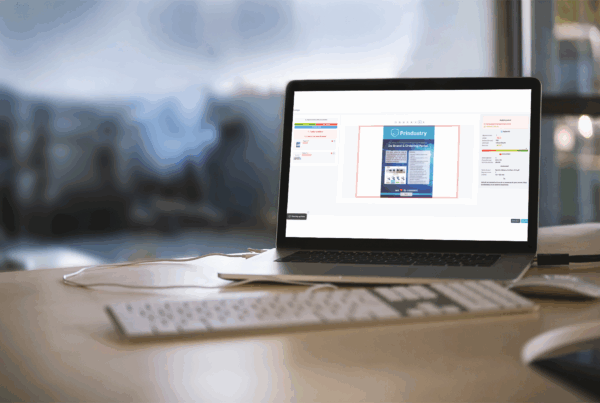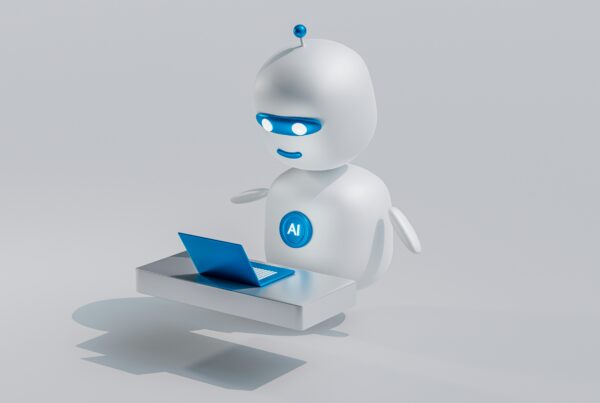Prindustry on AI: a look to the future
In a series of articles on artificial intelligence, Peter Luit of Printmedianieuws interviewed several experts from the printing industry in early 2025. Ramon van Wingerden of Prindustry was the first expert to share his views on the opportunities and possibilities of AI for customers and services.
Printmedianieuws wonders how AI can predict which assignments clients will place in the future. Ramon: “Let me start by noting that when clients start searching for something, Google doesn’t provide answers. In fact, when someone searches for a specific product, all you get from Google is a list of advertisements/providers that could potentially offer the requested product. AI is going to change that process in my opinion, you are not going to search but ask for your desired product(s), to which AI is then going to give a much more focused answer. Of course, the quality of that answer depends on the details you ask around the desired product.”

“Customer behavior is going to change tremendously under the influence of AI. Google searches are going to be replaced by getting targeted answers to targeted questions through AI.”
Smarter product choices with AI in Prindustry Platform
Ramon states that the Prindustry software team is in the process of incorporating AI capabilities to ask questions around desired products instead of ticking numerous options to define a product. AI will then recommend the most suitable manufacturer from the range of products within the Prindustry Portal. “Realize that this alone is a huge task. There is no ‘standard language’ to define print media products, the number of variables (and often their names) is too varied for that. So step one is to come up with a set of standard ‘expressions’ to engage in this process at all.”


The user interface for the Prindustry order portal will change significantly in the coming years under the influence of AI
AI in the print industry: Revolution with appropriate speed
Is AI for Prindustry “the next big thing? Ramon: “I think for everyone. But despite the enormous speed of AI as we discover it now, it will really take a few more years before AI as a machine can start doing the job 100% in this area within the industry.” He backs this up with the fact that the print media industry is simply not at the forefront of “super-fast switching” to new technology. “Everything moves at an appropriate speed, look for example at the market share of inkjet, which is still relatively small compared to analog production processes.”
The challenge of AI in a fragmented client market
The client market is leading, according to Ramon. “Realize well that the client market in our industry is so huge that it will be a big job to manage the advance of AI within those target groups. Many still don’t quite know how to describe diverse assignments. The added value of our resellers lies mainly in that aspect; unburdening the ultimate client and offering them convenience and efficiency. So that very often applies to a bundled set of orders that now still have to be dispersed among different products.”
“It will mainly be the clients who, with their changing behavior, are going to enforce AI within the industry.”

AI is changing the role of software developers
When asked if the competencies of Prindustry’s own software developers will change, Ramon replies, “Certainly, it is already happening. Previously the developed code was checked and modified manually, where necessary, now we let AI do that check. There are already powerful tools available for that. If you go one step further, you’re already seeing tools that can already predict ‘the next line’, so to speak, based on the previous piece of input code.”
“Our employees are sometimes surprised by the code that AI predicts, because AI already has an excellent understanding of the context of development.”
Ramon argues that you have to keep a close eye on that kind of development: “I do want our developers to keep thinking very carefully and to see AI as support and therefore not take over their tasks with ease. The context of what we want to develop is real human intelligence.”

AI: still a learning process for man and machine
Although artificial intelligence has made great strides in recent years, it is clear that there is still room for improvement. AI models like ChatGPT and tools like Microsoft Co-pilot have impressive capabilities, but in practice they still sometimes appear to run into limitations.
“One of our developers confronted ChatGPT some time ago by asking what ‘one plus one’ is. The answer, of course, was ‘two.’ ‘ The developer subsequently indicated in the next question line that he doubted that, and then you see ChatGPT doing crazy things with something so simple. ChatGPT starts doubting it, too.” Laughing, he adds, “I hope this has improved by now.”
Ramon also reflects on the example where he used Microsoft Co-pilot to analyze a complex Excel sheet, specifically formulas entered by a client to define a range of print media products. “I asked for an analysis of a cell, Co-pilot didn’t come up with one, even after I took each cell’s contents in the prompt itself and provided context. More than once, a response appeared that ‘he’ didn’t get any further with it. So within all the promise of AI anno 2025, it is really still a process of ‘learning by doing’, for both ‘human and machine’.
AI on the road to 2030: from potential to practical solutions
“Everything is not yet perfect as of 2025, but things are moving fast. I dare say that well before 2030 the number of really useful tools will have increased enormously, also within our industry. You can imagine then that you will get a focused and above all useful answer to the question ‘I will be at trade show X in 2 months, put together a flyer for me based on our corporate identity, make a brochure with our most important services/products, make a poster to decorate the booth with a QR code for making an appointment via our website’. That is really about to happen, if you already look at Canva for example, you will discover what AI potentials are coming.”







